Air of Authority - A History of RAF Organisation
No 211 - 215 Squadron Histories
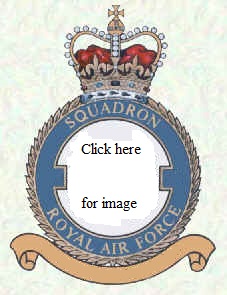 Formed
originally at Petite Synthe as No 11 (Naval) Squadron RNAS on 8 Mar 1917 it
disbanded on 27 August. It reformed, again at Petite Synthe on 10 March
1918 equipped with DH4s and DH9s but less then a month later it was absorbed
into the RAF as No 211 Squadron. It took part in bombing and
reconnaissance operations in the Flanders area for the remainder of the war,
retuning to the UK in March 1919, disbanding at Wyton on 24 June.
Formed
originally at Petite Synthe as No 11 (Naval) Squadron RNAS on 8 Mar 1917 it
disbanded on 27 August. It reformed, again at Petite Synthe on 10 March
1918 equipped with DH4s and DH9s but less then a month later it was absorbed
into the RAF as No 211 Squadron. It took part in bombing and
reconnaissance operations in the Flanders area for the remainder of the war,
retuning to the UK in March 1919, disbanding at Wyton on 24 June.
Reformed in the day bomber role on 24 June 1937 at Mildenhall, it was initially equipped with Audaxes, with Hinds arriving in August and by October the last Audax had left. At the end of April 1938, the squadron embarked for the Middle East, arriving at Helwan in May. It undertook its first operations of the war in June 1940, following the declaration of war by Italy. These missions were mounted against Italian targets in Libya and continued until November 1940 when the squadron was sent to assist the Greeks following the Italian invasion of that country. It carried out raids against Italian bases in Albania into 1941 but was forced to withdraw back to Egypt in April following the German intervention in the campaign.
It now moved to Palestine where it re-equipped and then took part in the operation to capture Syria from the Vichy French, after which it moved south to the Sudan, where it undertook operational training duties as part of No 72 OTU from November 1941. However, the following month the squadron was re-established in its own right and embarked for the Far East. Destined for Singapore, the island had fallen by the time it arrived and it was redirected to Sumatra, from where it operated until mid-February, when it moved to Java, here its aircraft were handed over to No 84 Squadron and the squadron disbanded on 19 February 1942.
The squadron reformed again on 14 August 1943 at Phaphamau, but it was October before its equipment in the form of Beaufighter Xs arrived. Beginning operations on 13 January 1944, it carried out rocket and cannon attacks against river craft and other lines of communications. These operations continued until May 1945, when the squadron was withdrawn to India. Here it re-equipped with Mosquito VIs, which it was due to utilise in the projected invasion of Malaya. However, the invasion never took place, owing to the Japanese surrender following the dropping of the atomic bombs on Hiroshima and Nagasaki. As a result the squadron re-located to Bangkok in Siam (Thailand) in September 1945 and disbanded at Don Muang on 15 March 1946.
Squadron Codes used: -
| AO | Oct 1938 - Mar 1939 |
| LJ | Apr 1939 - Sep 1939 |
| UQ | Sep 1939 - Feb 1942 |
 |
 |
| Bristol Blenheim I of No 211 Sqn coded LJ ©C F R Clark |
Hawker Hind of No 211 Sqn - Grantham 1938 ©Mike Grierson |
 |
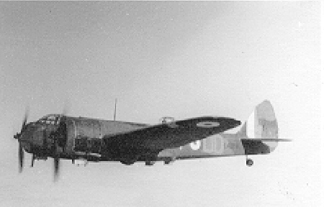 |
| Hawker Audax of No 211 Sqn - Mildenhall 1937 ©Mike Grierson |
Blenheim I of No 211 Sqn coded UQ ©C F R Clark |
 |
|
| Hawker Hind (K6855) of No 211 Sqn, Ramleh, Palestine - 1938 ©Mike Grierson | |
[Aircraft & Markings | Personnel, aircraft and locations | Commanding Officers]
Don Clark's No 211 Squadron Website
 No
12 Squadron RNAS was formed as a training unit within No 1 Wing at Hondschoote
on 8 June 1917, however, unlike other RNAS units it was not absorbed into the
RAF as No 212 Squadron and disbanded on 1 April 1918. On the same
day the assets of RNAS Great Yarmouth were formed into Flights but on 20 August
these flights were formed into squadron, the landplane flights (No's 490, 557 &
558) becoming No 212 Squadron. Equipped with DH4s, DH9s and DH9As it
carried out anti-submarine patrols over the North Sea until the end of the
war. In March 1919 it moved to Swingate Down, where it disbanded on 9
February 1920.
No
12 Squadron RNAS was formed as a training unit within No 1 Wing at Hondschoote
on 8 June 1917, however, unlike other RNAS units it was not absorbed into the
RAF as No 212 Squadron and disbanded on 1 April 1918. On the same
day the assets of RNAS Great Yarmouth were formed into Flights but on 20 August
these flights were formed into squadron, the landplane flights (No's 490, 557 &
558) becoming No 212 Squadron. Equipped with DH4s, DH9s and DH9As it
carried out anti-submarine patrols over the North Sea until the end of the
war. In March 1919 it moved to Swingate Down, where it disbanded on 9
February 1920.
Experiments by the Photographic Development Unit in the use of unarmed Spitfires for photographic reconnaissance had lead to early examples being sent to France in February 1940. This detachment was given the designation No 212 Squadron on 10 February 1940 and continued to operate from continental bases until its evacuation in June. During this period it operated its Spitfires and Blenheims on strategic reconnaissance sorties over Germany. On its return to Britain it was absorbed back into the PDU and disbanded on 18 June 1940.
The squadron reformed again on 22 October 1942. It was now destined to operate Catalinas from Korangi Creek near Karachi, but its first aircraft did not arrive until December. It continued to carry out anti-submarine patrols and air sea rescue missions over the Indian Ocean, Persian Gulf and Arabian Sea as well as along the Indo-Burmese coastline. It moved to Madras in May 1945, where it was re-numbered No 240 Squadron on 1 July 1945.
.
Squadron Codes used: -
| QB | Allocated Apr 1939- Sep 1939 |
[Aircraft & Markings | Commanding Officers]
 Formed
on 1 April 1918 by re-numbering No 13 Squadron RNAS. This unit had been
formed in June 1917 as the Seaplane Defence Flight and was tasked with defending
the Seaplanes operating out of Dunkirk. It was redesignated No 13 (Naval)
Squadron on 15 January 1918. It continued its fighter and escort role
until the end of the war and returned to Britain (Scopwick) in March 1919, where
it disbanded on 31 December of that year.
Formed
on 1 April 1918 by re-numbering No 13 Squadron RNAS. This unit had been
formed in June 1917 as the Seaplane Defence Flight and was tasked with defending
the Seaplanes operating out of Dunkirk. It was redesignated No 13 (Naval)
Squadron on 15 January 1918. It continued its fighter and escort role
until the end of the war and returned to Britain (Scopwick) in March 1919, where
it disbanded on 31 December of that year.
The squadron reformed, again in the fighter role on 8 March 1937 at Northolt. Equipped with Gauntlets it moved to Church Fenton in July 1937 and in May 1938 to Wittering. At Wittering it re-equipped with Hurricanes in January 1939 and a detachment of these was sent to France in May 1940 with the rest of the squadron moving to Biggin Hill in June. It remained in the south throughout the Battle of Britain, although it was in the South-West until September when it moved to Tangmere. November 1940 saw it move back to Yorkshire and February 1941 a move further north to Castletown in Scotland.
However, in May 1941, the squadron boarded HMS Furious, from where it took off on the 21st of the month to Malta. Following refuelling the squadron carried on to Egypt but its aircraft were attached to other units and it was July before the squadron operated in its own right, when it took part in operations over Syria. It then went to Cyprus until December 1941 when it returned to Egypt. Air Defence duties were followed by offensive mission from June 1942 after which the squadron moved westwards supporting the 8th Army following the breakout at El Alamein. During this period the squadron actually operated from bases behind the enemy lines.
In March 1943 it undertook night defence duties and convoy patrols until July when it returned to the Nile Delta area where it carried out shipping patrols and occasional sweeps over Crete. The squadron re-equipped with Spitfires in February 1944 and in July moved to Italy as part of No 283 Wing, having re-equipped again in May, this time with Mustangs. These were used to good effect in ground attack missions over Yugoslavia and Albania, the squadron becoming part of the Balkan Air Force when it was formed in June 1944.
With the end of hostilities, the squadron moved to Palestine in September 1945 and a year later to Cyprus, where it was to become a permanent component of the Middle East command. Tempests F Mk 6s were received in January 1947, taking these to Egypt in early September and the Sudan in October. Another move within the area took place in August 1948, when the squadron went to Mogadishu in Somaliland, before returning to Egypt two months later, where it re-equipped with Vampires. It continued to fly these on air defence duties in the Canal Zone until disbanding at Deversoir on 30 September 1954.
Less than a year later the squadron reformed on 1 September 1955, although at this stage it did not receive any aircraft. These arrived in March 1956 and it was now a Canberra Interdictor unit, forming part of the Bruggen Wing in Germany, being equipped with the B(I) Mk 6 model of the aircraft. It continued to operate the type until 5 December 1969 when it disbanded for the last time.
| Standards | Battle Honours* |
| Award of Standard originally announced on 10 Oct 1961, effective from 1 Apr 1961 but presented:- |
Western Front, 1918: Channel & North Sea, 1939-40: France & Low Countries, 1940: Dunkirk: Battle of Britain, 1940: Home Defence, 1940-41: Egypt & Libya, 1941-43: Syria, 1941: El Alamein: Mediterranean, 1942-43: South-East Europe, 1943-45: |
Squadron Codes used: -
| AK | Apr 1939 - Jan 1950 |
[Aircraft & Markings | Personnel, aircraft and locations | Commanding Officers]
No 213 Squadron Association website
No 214 (Federated Malay States) Squadron
 No
14 (Naval) Squadron had been formed at Coudekerque on 28 July 1917 as No 7A
Squadron, adopting the number 14 on 9 December 1917. Equipped with the
Handley Page O/100 bomber, it became No 214 Squadron on the formation of the RAF
on 1 April 1918. It was involved in carrying out bombing attacks against
enemy strategic targets in Belgium and Northern France. It received the
O/400 in June 1918, continuing in this role until the end of the war. In
July 1919, the squadron moved to Egypt but disbanded on 1 February 1920 by being
absorbed into No 216 Squadron.
No
14 (Naval) Squadron had been formed at Coudekerque on 28 July 1917 as No 7A
Squadron, adopting the number 14 on 9 December 1917. Equipped with the
Handley Page O/100 bomber, it became No 214 Squadron on the formation of the RAF
on 1 April 1918. It was involved in carrying out bombing attacks against
enemy strategic targets in Belgium and Northern France. It received the
O/400 in June 1918, continuing in this role until the end of the war. In
July 1919, the squadron moved to Egypt but disbanded on 1 February 1920 by being
absorbed into No 216 Squadron.
The squadron reformed on 16 September 1935 from a nucleus provided by 'B' Flight of No 9 Squadron at Boscombe Down. It was still in the night bomber role, equipped with the Vickers Virginia X. A move to Scampton was followed by re-equipment with Harrows in January 1937 and further re-equipment with Wellingtons in May 1939. It operated various models of Wellington on night raids as part of Bomber Command's main force until April 1942. The squadron re-equipped with the Stirling and continued in the same role until January 1944.
However, at this point the squadron underwent a major change in both equipment and role. It was now equipped with Fortress II and III aircraft, which were specially modified for the electronic counter-measures role. In this role the squadron was part of No 100 Group and it continued to carry out a wide range of ECM duties until the end of the war, disbanding on 27 July 1945. Almost immediately No 614 Squadron in Italy was re-numbered 214 and in August, it took its Liberators to Palestine but on 15 April 1946, it was disbanded again by being re-numbered No 37 Squadron.
Later that year, on 4 November , the squadron reformed at Upwood as a bomber unit, initially equipped with the Lancaster B 1(FE), but in February 1950 these were replaced with Lincolns. During this period the squadron saw 'active' service when a detachment was sent to Kenya to operate against 'Mau-Mau' terrorists, before disbanding again on 30 December 1954. The squadron briefly reformed at Laarbruch on 15 June 1955 as a Canberra PR Mk 7 equipped photo-reconnaissance unit. However, it career in this role was brought to an end less than two months later, when on 1 August, it was renumbered as No 80 Squadron.
It reformed once again on 21 January 1956 as part of the V-Force, equipped with the Valiant. These were used in action during Operation Musketeer, the Anglo-French Suez campaign. In 1958 it became the first squadron in the RAF to operate air-to-air refuelling tankers, a role it remained in for the rest of its service life. During this period it undertook many long distance flights to prove the operational worth of the system, setting many new world records in the process. However, the failure of the main spars on some Valiants brought the useful life of these aircraft to a premature end and the squadron disbanded on 28 February 1965.
When new equipment became available, No 214 was reformed, on 1 July 1966 at Marham. It was now equipped with an air-to-air refuelling version of the Victor, which continued to operate until its final disbandment on 28 January 1977. During this period it provided a valuable service to both fighter and strike units of the RAF during deployments and exercise.
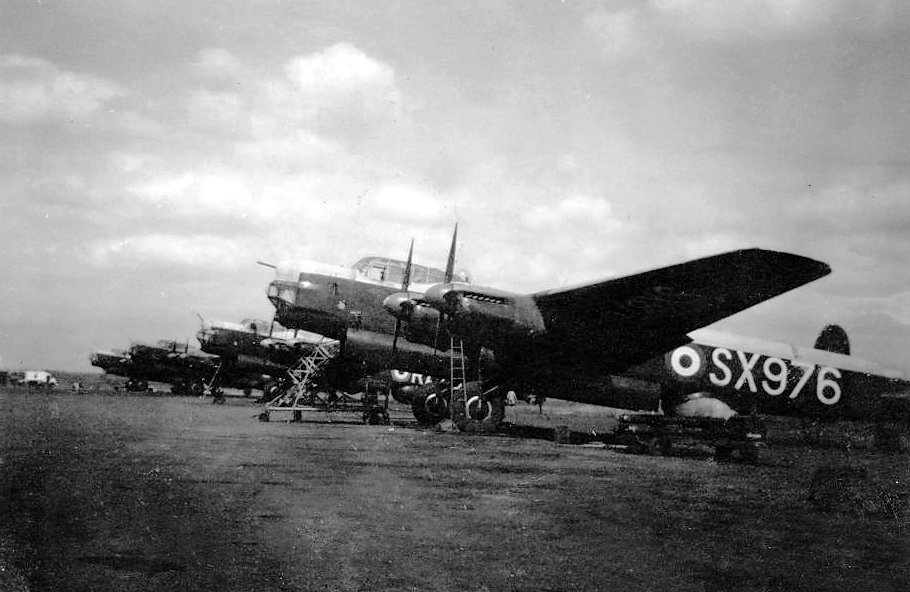 |
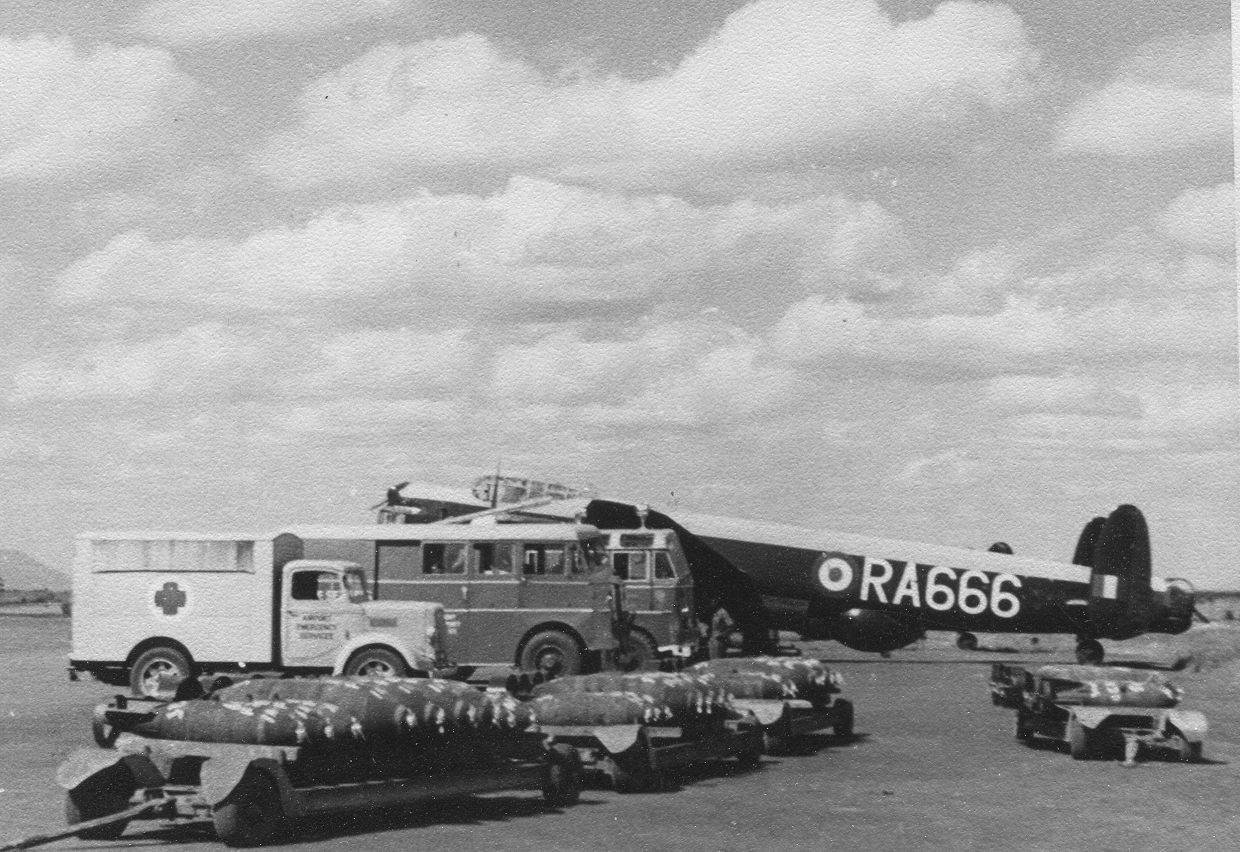 |
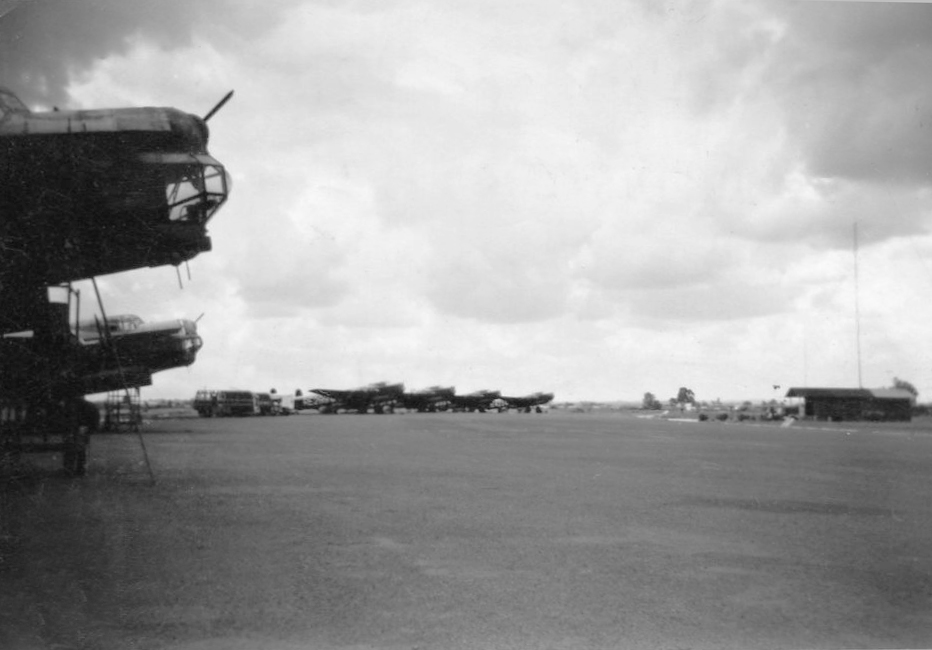 |
| The photos above show Lincolns of No
214 Squadron at RAF Eastleigh in 1954 Photos courtesy - Kevin Patience© |
| Standards | Battle Honours* |
| Award of Standard originally announced on 10 Oct 1961, effective from 1 Apr 1961 but presented:- |
Western Front, 1917-18: Biscay Ports, 1940-44: German Ports, 1940-45: Ruhr, 1940-45: Fortress Europe, 1940-44: Invasion Ports, 1940: Berlin, 1940-45: Channel & North Sea, 1942-44: Baltic, 1942-44: Normandy, 1944: France & Germany, 1944-45: |
Squadron Codes used: -
| 214 | Jan 1937 - Apr 1939 |
| UX | Apr 1939 - Sep 1939 |
| BU | Sep 1939 - Jul 1945 |
| QN, PX* | Nov 1946 - Apr 1951 (*only used by 'C' Flt) |
[Aircraft & Markings | Personnel, aircraft and locations | Commanding Officers]
 Formed
at Couderkerque on 1 April 1918 by renumbering No 15 Squadron RNAS, which had
only been in existence since 10 March 1918, it was equipped with O/100s in the
night bombing role. However, three weeks later it returned to Netheravon
where it re-equipped with the improved O/400. When it returned to
operations in France in July, it was assigned to the Independent Force, with
whom it carried out strategic bombing attacks against targets in Germany.
It remained in France following the end of the war, but returned to the UK in
February 1919, disbanding at Ford on 18 October of that year.
Formed
at Couderkerque on 1 April 1918 by renumbering No 15 Squadron RNAS, which had
only been in existence since 10 March 1918, it was equipped with O/100s in the
night bombing role. However, three weeks later it returned to Netheravon
where it re-equipped with the improved O/400. When it returned to
operations in France in July, it was assigned to the Independent Force, with
whom it carried out strategic bombing attacks against targets in Germany.
It remained in France following the end of the war, but returned to the UK in
February 1919, disbanding at Ford on 18 October of that year.
The squadron reformed on 1 October 1935 from a nucleus provided by 'A' Flight of No 58 Squadron. Based at Worthy Down it was equipped with Virginias. In February 1937, the squadron also received some Ansons, which it used for conversion training onto monoplanes, this was in readiness for the arrival of Harrows in August. The squadron was fully equipped by November 1937 and the Ansons left, together with the last of the Virginias. Further re-equipment began in July 1939 when Wellingtons arrived, the last Harrows leaving in December. However, when war was declared in September, instead of starting operations, No 215 became a training unit, being absorbed into No 11 OTU on 8 April 1940.
215 briefly resurfaced on the same day when a new unit began to form at Honington, but this was short-lived as it was absorbed by No 11 OTU again on 22 May. It was over a year before a new 215 formed, on 9 December 1941, and this time it was destined for overseas. The ground element left in February 1942 for India, whilst the air element formed at Waterbeach, beginning 21 February. Equipped with Wellingtons, it flew out to India in late March, arriving in April. It immediately began supply dropping following the retreat from Burma, it also undertook coastal patrols and from October, airborne forces training.
Eventually in March 1943 it began to carry out its primary role, bombing, which it continued to fulfil until being withdrawn from operations on 23 June 1944. It now converted to Liberators, resuming both day and night bombing operations on 1 October, but in April 1945, the squadron had its Liberators replaced by Dakotas and now assumed the transport role. Supply dropping now became the main activity in support of the 14th Army, until October when the squadron re-located to Malaya. Its area of operations now covered Malaya, Java and Hong Kong and it operated in the transport role until disbanded by being re-numbered No 48 Squadron on 15 February 1946.
Eighteen months later, 1 August 1947, the squadron reformed at Kabrit in Egypt, still in the transport role and still equipped with Dakotas. However, on 1 May 1948, the squadron was re-numbered No 70 and it was another eight years before it was revived, this time at Dishforth, equipped with Pioneer CC Mk 1 aircraft on 30 April 1956. It operated in the communications and army support role until 1 September 1958 when it was disbanded by being re-numbered No 230. So far its final period of service began 1 May 1963 when it was reformed as medium range transport unit equipped with the Argosy at Benson. In the following August it moved to Singapore, where it supported the Army in Malaya until finally disbanding at Changi on 31December 1968.
Squadron Codes used: -
| BH | Apr 1939 - Sep 1939 |
| LG | Sep 1939 - Apr 1940 |
[Aircraft & Markings | Personnel, aircraft and locations | Commanding Officers]
Squadron badge image on this page is courtesy of Steve Clements
© Crown Copyright is reproduced with the permission of the Directorate of Intellectual Property Rights
This page was last updated on 01/07/23©
![]() Organisational Index
Organisational Index ![]()